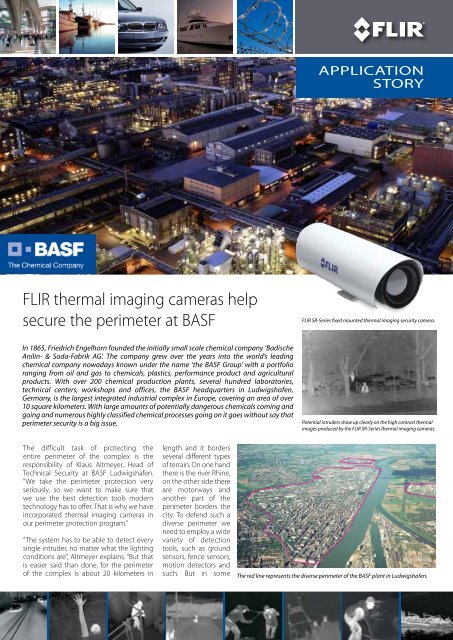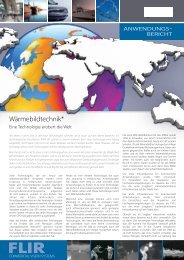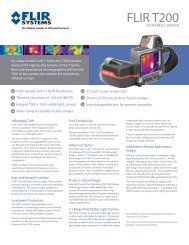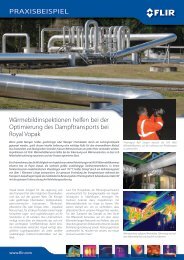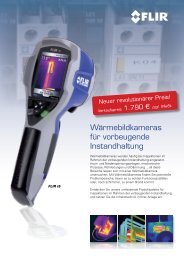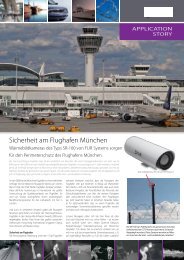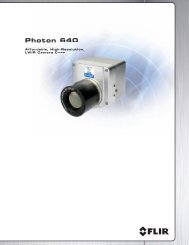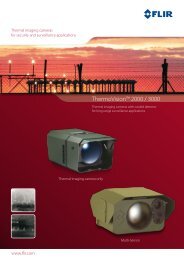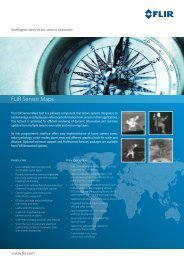Download Application Story - FLIR Systems
Download Application Story - FLIR Systems
Download Application Story - FLIR Systems
Create successful ePaper yourself
Turn your PDF publications into a flip-book with our unique Google optimized e-Paper software.
<strong>FLIR</strong> thermal imaging cameras help<br />
secure the perimeter at BASF<br />
In 1865, Friedrich Engelhorn founded the initially small scale chemical company ‘Badische<br />
Anilin- & Soda-Fabrik AG’. The company grew over the years into the world’s leading<br />
chemical company nowadays known under the name ‘the BASF Group’ with a portfolio<br />
ranging from oil and gas to chemicals, plastics, performance product and agricultural<br />
products. With over 200 chemical production plants, several hundred laboratories,<br />
technical centers, workshops and offices, the BASF headquarters in Ludwigshafen,<br />
Germany, is the largest integrated industrial complex in Europe, covering an area of over<br />
10 square kilometers. With large amounts of potentially dangerous chemicals coming and<br />
going and numerous highly classified chemical processes going on it goes without say that<br />
perimeter security is a big issue.<br />
The difficult task of protecting the<br />
entire perimeter of the complex is the<br />
responsibility of Klaus Altmeyer, Head of<br />
Technical Security at BASF Ludwigshafen.<br />
“We take the perimeter protection very<br />
seriously, so we want to make sure that<br />
we use the best detection tools modern<br />
technology has to offer. That is why we have<br />
incorporated thermal imaging cameras in<br />
our perimeter protection program.”<br />
“The system has to be able to detect every<br />
single intruder, no matter what the lighting<br />
conditions are”, Altmeyer explains. “But that<br />
is easier said than done, for the perimeter<br />
of the complex is about 20 kilometers in<br />
length and it borders<br />
several different types<br />
of terrain. On one hand<br />
there is the river Rhine,<br />
on the other side there<br />
are motorways and<br />
another part of the<br />
perimeter borders the<br />
city. To defend such a<br />
diverse perimeter we<br />
need to employ a wide<br />
variety of detection<br />
tools, such as ground<br />
sensors, fence sensors,<br />
motion detectors and<br />
such. But in some<br />
application<br />
story<br />
<strong>FLIR</strong> SR-Series fixed mounted thermal imaging security camera.<br />
Potential intruders show up clearly on the high contrast thermal<br />
images produced by the <strong>FLIR</strong> SR-Series thermal imaging cameras.<br />
The red line represents the diverse perimeter of the BASF plant in Ludwigshafen.
application<br />
story<br />
areas many of these tools are simply not<br />
satisfactory. They might produce too many<br />
unwanted alarms, due to vibrations caused<br />
by heavy traffic, for instance, or the layout<br />
might not leave enough room for them to<br />
be installed, or environmental factors make<br />
their use impractical. We therefore needed<br />
a long range detection tool to provide<br />
improved perimeter security.”<br />
At first Altmeyer investigated the use of<br />
visual light CCTV cameras, combined with<br />
advanced video analytics software. “But in<br />
my experience automatic video detection<br />
does not work in outside conditions, at<br />
least not to the high standards we have<br />
here at BASF. In bad lighting conditions<br />
the video footage from CCTV cameras<br />
simply do not provide enough contrast<br />
for automatic intruder detection. Then I<br />
learned that <strong>FLIR</strong> <strong>Systems</strong> was marketing<br />
a new product: thermal imaging cameras<br />
for perimeter security. I made contact<br />
with Bertrand Völckers from <strong>FLIR</strong> <strong>Systems</strong><br />
and he demonstrated this new product. I<br />
immediately realized that this was exactly<br />
the type of sensor I was looking for.”<br />
<strong>FLIR</strong> SR-Series thermal imaging cameras have been placed at<br />
strategic locations along the area’s perimeter.<br />
CCTV cameras rely on color contrast and<br />
are therefore dependent on the presence<br />
of enough light to generate high contrast<br />
footage. Thermal imaging cameras record<br />
infrared radiation, which is emitted by all<br />
objects as a function of their temperature.<br />
The temperature difference between a<br />
human body and its surroundings allow<br />
thermal imaging cameras to provide high<br />
contrast images that the video analysis<br />
software can use to accurately detect<br />
intruders regardless of lighting conditions.<br />
Extensive tests<br />
To make sure that a system based on<br />
thermal imaging detection tools would<br />
Klaus Altmeyer, Head of Technical Security at BASF<br />
Ludwigshafen<br />
CCTV camera <strong>FLIR</strong> SR-series camera<br />
function perfectly Altmeyer performed<br />
extensive tests before purchasing the first<br />
cameras. “After we were certain it would<br />
work we bought a couple of dozens of <strong>FLIR</strong><br />
thermal imaging cameras to secure the river<br />
bank. This was back in 2007. The thermal<br />
imaging cameras proved to be a very good<br />
solution. After seeing the success of the<br />
thermal imaging cameras at this location<br />
we decided to expand the use of thermal<br />
imaging cameras.”<br />
Depending on the requirements of a<br />
particular location with regard to field of<br />
view the <strong>FLIR</strong> SR-324 or SR-334 was used.<br />
If the advanced video analytics software<br />
detects movement on the thermal footage<br />
these cameras produce, CCTV cameras on<br />
a pan and tilt platform are automatically<br />
pointed at the location of the intrusion, to<br />
give the guards in the control room the best<br />
possible view of the situation. “During the<br />
daytime we can use those CCTV cameras to<br />
identify the subject. If the alarm is triggered<br />
during the night, we send out walking<br />
patrols with dogs to investigate.”<br />
Easy installation and low maintenance<br />
Installing the <strong>FLIR</strong> thermal imaging cameras<br />
was relatively easy and the system requires<br />
little to no maintenance, according to<br />
Altmeyer. “We already had masts in place<br />
for the CCTV cameras, so all we had to do<br />
was to affix the thermal imaging camera,<br />
plug in the power cable and the fiber<br />
optics cable that transports the thermal<br />
video footage to the central control room.<br />
No additional infrastructure was required.<br />
We’ve been using these thermal imaging<br />
cameras from <strong>FLIR</strong> <strong>Systems</strong> for years now,<br />
operating 24/7, and not once did we have<br />
a technical problem. No maintenance was<br />
needed until now.”<br />
The BASF control room is the hub of the security network, where<br />
all footage from CCTV and thermal imaging cameras is analyzed.<br />
“The unwanted alarm rate is also very<br />
low”, Altmeyer explains. “Thermal imaging<br />
cameras rely on thermal contrast instead<br />
of color contrast, so the video analysis<br />
software can very accurately distinguish<br />
between an actual intruder and flying birds<br />
or shimmering water, for instance. The only<br />
unwanted alarms we had in all these years<br />
were actually welcomed by the guards.<br />
When specialists of our environmental<br />
department come to take water samples<br />
at the river bank then the alarm goes off.<br />
But this is actually a good thing, the control<br />
room guards assure me, for this confirms<br />
that the system really works.”<br />
Mobile thermal imaging<br />
The success with the <strong>FLIR</strong> SR-Series fixed<br />
mounted thermal imaging cameras has<br />
also lead to the purchase of mobile hand<br />
held thermal imaging cameras of the <strong>FLIR</strong><br />
HS-Series. “We have bought two of these<br />
cameras for the guards to take with them<br />
when they investigate an alarm at night. The<br />
guards can use the thermal imaging camera<br />
to see whether there really is an intruder<br />
and where that intruder is, allowing them<br />
to prepare for the encounter. This not only<br />
helps with the early detection of intruders,<br />
but also enhances employee safety.”<br />
“I am very happy with the overall<br />
performance of the <strong>FLIR</strong> <strong>Systems</strong> thermal<br />
imaging cameras”, concludes Altmeyer. “I<br />
am convinced that thermal imaging might<br />
also be a solution for the security issues that<br />
some other BASF sites are facing.“<br />
For more information about thermal imaging<br />
cameras or about this application,<br />
please contact:<br />
Flir commercial systems B.V.<br />
Charles Petitweg 21<br />
4847 NW Breda - Netherlands<br />
Phone : +31 (0) 765 79 41 94<br />
Fax : +31 (0) 765 79 41 99<br />
e-mail : flir@flir.com<br />
www.flir.com<br />
AS_1110_0050_EN


